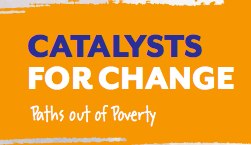Future Now
The IFTF Blog
Living Infrastructures | #Catalyze4 Zone of Innovation
 During our 2010 Catalysts for Change Foresight Engine Game we asked players to uncover new paths out of poverty. What new ways could we go about building our world in order to create resilience and prosperity for all?
During our 2010 Catalysts for Change Foresight Engine Game we asked players to uncover new paths out of poverty. What new ways could we go about building our world in order to create resilience and prosperity for all?
The first Future Zone of Innovation, Living Infrastructures, grapples with how we can work more closely with our natural environment in order to create healthier and more resilient urban systems. Whether bringing the environment into dense urban areas, expanding green technology, or pushing the envelope and building actual living infrastructures that are self-sufficient machines, all these ideas tend to focus on creating a healthy symbiotic relationship between the environment and people as a pathway towards poverty alleviation.
One player brought our attention to the Venus Project, which is focused on radically changing the way we design our world in order to move past war and poverty. Among other things, they suggest we transition to a resource-based economy in which we use existing resources rather than money. And of course, intrinsic to the goals of the resource-based economy is a way to equitably distribute the planet’s resources in the most efficient manner for the entire population. We talk about this concept from time to time at IFTF, but I wonder, why would a resource-based economy push us to become more equitable? For the Venus Project, this can happen if we use all our technology and scientific knowledge to create resource abundance eliminating the need for rationing, hoarding, or greed.
Imagine a resource based economy coupled with living infrastructures like 4D printing technologies —think self-assembly structures that can assemble themselves and change when needed— and actual living houses like this bioreactive façade. Is this more of a utopian dream than something tangible for the billions of people around the globe currently living in poverty?
What do you think? Will looking to our natural ecosystem, both for micro and macro interventions give us new solutions to the age old conundrum of poverty alleviation and economic equality?
Join the debate!

This post is from Catalysts for Change, a journey we undertook to uncover new paths out of poverty with the Rockefeller Foundation, their Searchlight Partners, and a global community of concerned citizens. We analyzed 18,000 ideas from a global participatory game on our Foresight Engine platform, to uncover 25 new zones of innovation--new paths out of poverty. In the coming weeks, look for more about the innovation zones and opportunities they present to make the future.
Curious about Catalysts for Change?
- Follow the projects at @iftf, @catalyze4change, #Catalysts4
- Find out more about the initiative on our website
- Contact Tessa Finlev (tfinlev@iftf.org)



